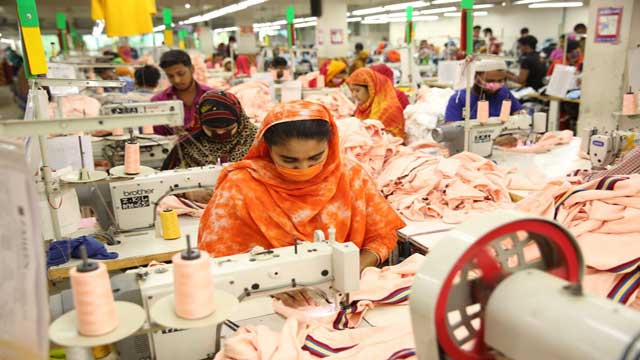As many as 3.57 lakh garment workers lost their jobs for the pandemic, finds a survey, which is much higher than the official figure of 56,372 apparel workers.
The information was revealed during a virtual dialogue on Saturday, jointly conducted by the Centre for Policy Dialogue and Mapped in Bangladesh (MiB).
A good number of workers were recruited in the sector, but the actual figure could not be deduced, said the survey, titled “Vulnerability, Resilience and Recovery in the RMG Sector in view of Covid Pandemic: Findings from the Enterprise Survey,”.
The survey was conducted from October to November last year, on 610 enterprises out of 3,211 listed enterprises.
The enterprises are located in the four major industrial clusters of Dhaka, Gazipur, Narayanganj and Chittagong.
“Most of the apparel factories did not follow the layoff rules amid the pandemic,” said Khondaker Golam Moazzem, research director at CPD, in his keynote presentation.
Only 3.6 per cent complied with the compensation principle and paid salary, outstanding wages and other compensations.
About 70 per cent of the factories only paid wages. Non-compliance is much higher in factories located in Narayanganj and large-sized factories.
Although the official percentage of layoffs were shown to be 2.2 per cent out of 25.62 lakh apparel workers across the country (as per MiB database), the survey found that the actual percentage was 13.9 per cent.
Due to the pandemic, the size of operation of factories has scaled down. The average number of workers in a factory during December 2019 was 886, which came down to 790 in September 2020.
The overall gender composition did not change in the sector. But as many as 33 per cent factories have a lower share of females at present compared with that in the pre-pandemic period, the findings showed.
In absorbing shocks of any crisis, the resilience of Bangladesh’s garment sector was found lower than the global average: the resilience index of sampled enterprises, calculated based on Argonne 2010, was 43.4 out of 100.
The financial management system was very poor. The manufacturers could not even absorb the shock for one or two months, said trade union leaders.
Overall resilience performance is below the average, while its major strengths are in coordination and awareness.
But its weaknesses are spread across various issues, most importantly in case of maintaining key functions and alternate sites, Moazzem said.
Dependence on a very small number of buyers is a major weakness, not only for small enterprises but also for large-scale enterprises.
The financial management of garment enterprises is very poor.
The majority of the factories, including those of large enterprises, did not have a financial backup or a plan to cope with the immediate crisis, he added.
The resilience and recovery will require proper planning and development concerning robustness, resources and recovery-related issues, while most importantly factories need to diversify its sources of industrial raw materials and the ability to maintain key functions, the CPD said.
It is important to make the application process for stimulus packages easier to apply for small scale enterprises.
Despite making the terms easier, a section of enterprises did not apply due to their inability to pay monthly instalments, the research findings showed.
Stimulus package covered the demand of 70 per cent of the enterprises. But about 30 per cent were left out of the package, mostly small and non-member factories, it showed.
About 70 per cent of the factories applied for subsidised credit under the government's stimulus package: 65 per cent applied for four months and 4 per cent applied for two months.
Some 17 per cent factories indicated that they did not apply due to non-eligibility.
A major focus should be to redirect those incentives to SMEs and non-member garment factories to facilitate their upgradation. This could be done in the upcoming national budget, Moazzem added.
The owners retrenched workers as per the law, as there were not enough work orders, said Mohammad Hatem, first vice president of BKMEA.
"However, the manufacturers reappointed or recruited workers later and the process is still continuing. If you look at the major industrial areas, you will find appointment notices and shortage of skilled workers," he added.
As many as 232 factories were closed down, of which 180 factories are associated with BGMEA and the rest with BKMEA.
About 60 per cent of the factories in the four main clusters recruited new workers amid the pandemic, the survey also said.
Recruitment of workers was high in Dhaka and Gazipur.
However, it was also found that a section of enterprises recruited their retrenched workers at a lower wage rate and temporarily.
Another issue raised by the survey was the fall in the use of safety measures, which came down to almost half of what it was before the pandemic. As many as 13.3 per cent of the factories reported having no measures taken.
The supplying country and suppliers absorb risk, but the buyers and brand are largely risk-free.
The workers' health risk is a big challenge for the industry,” said Rehman Sobhan, chairman and founder of CPD.
To overcome these challenges, a social insurance scheme with contributions from manufacturers, buyers and workers as well as donors could be looked into, he said.
Primarily, it would be for unscheduled unemployment, he added.
If the sector people do not concentrate on the health of workers, in future it would hit production, said Taslima Akhter, coordinator, Bangladesh Garment Workers Solidarity.
“Workers will perform better when they are in good health. So, post-pandemic health-related issues should be taken into consideration seriously,” she added.
mj/





